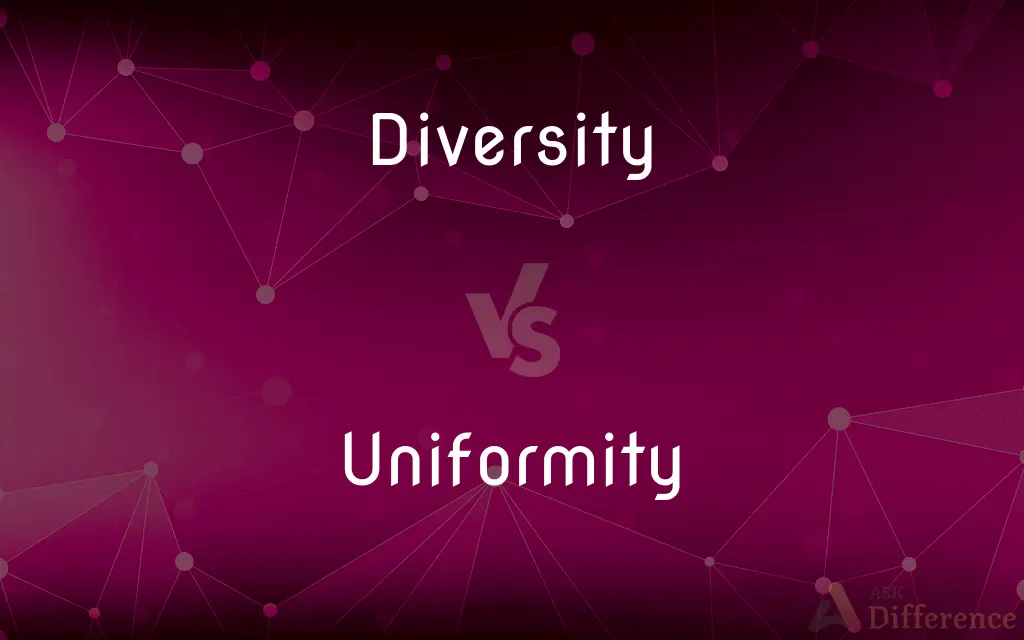Diversity vs. Uniformity — What's the Difference?
By Maham Liaqat & Urooj Arif — Updated on April 3, 2024
Diversity involves variety and differences within a group, enriching experiences, while uniformity ensures consistency and sameness, often simplifying processes.

Difference Between Diversity and Uniformity
Table of Contents
ADVERTISEMENT
Key Differences
Diversity refers to the inclusion and representation of different characteristics among individuals or elements within a group, encompassing aspects such as culture, race, gender, ideas, and more. It brings a richness of perspectives and creativity, enhancing innovation and problem-solving. On the other hand, uniformity implies a state of being the same or similar, promoting a sense of consistency and standardization that can simplify operations and ensure fairness in certain contexts.
In a workplace, diversity can drive innovation and growth by combining varied experiences and viewpoints, leading to more comprehensive and creative solutions. Uniformity, whereas, ensures that processes and standards are consistently applied, which can streamline operations and reduce complexity, making it easier to manage quality control and expectations.
Education systems that embrace diversity offer students a broader understanding of the world, teaching them to respect and appreciate different cultures and perspectives, thus preparing them for a globalized society. Conversely, uniformity in education, through standardized curriculums and testing, aims to provide all students with a consistent level of education and fair assessment methods.
In ecosystems, biodiversity is crucial for resilience and adaptability, allowing systems to withstand changes and disturbances. This diversity in species ensures ecosystem functionality and health. Uniformity, in contrast, can make systems more vulnerable to diseases and environmental changes, as seen in monoculture farming practices, which while efficient, increase susceptibility to pests and diseases.
The debate between diversity and uniformity extends to ethical and social considerations. Diversity advocates argue for the importance of inclusion and representation, highlighting the value of varied experiences and identities in enriching society and fostering empathy and understanding. Uniformity, on the other hand, can promote a sense of unity and coherence, but excessive emphasis may lead to the suppression of individuality and the marginalization of minority groups.
ADVERTISEMENT
Comparison Chart
Definition
The state of being diverse; variety.
The state of remaining the same; consistency.
Benefits
Enhances creativity, innovation, and problem-solving.
Simplifies processes, ensures fairness, and reduces complexity.
Application in Workplace
Drives growth through varied perspectives and experiences.
Streamlines operations and ensures consistent quality control.
Role in Education
Broadens understanding and prepares students for global society.
Provides consistent education level and fair assessments.
Ecological Impact
Increases resilience and adaptability of ecosystems.
Can make systems vulnerable to disturbances.
Ethical Considerations
Promotes inclusion and representation.
May lead to suppression of individuality if overemphasized.
Compare with Definitions
Diversity
Promotes empathy and global awareness in educational settings.
Diverse classrooms teach students valuable lessons in multiculturalism.
Uniformity
Aims for fairness through standardized policies and criteria.
Uniform standards in education seek to give every student an equal opportunity.
Diversity
Vital for the health and resilience of ecosystems.
Biodiversity ensures the stability and sustainability of our environment.
Uniformity
Can simplify operations and decision-making.
Adopting a uniform approach streamlined the company's workflow.
Diversity
Encourages the recognition and appreciation of individual differences.
Celebrating diversity means acknowledging each person's unique contributions.
Uniformity
Ensures consistency and standardization across processes.
Uniformity in manufacturing reduces errors and improves efficiency.
Diversity
Enhances innovation and creativity through a mix of perspectives.
Their diverse team brought forward groundbreaking solutions.
Uniformity
Advocates for unity and coherence within groups.
Uniform codes of conduct create a cohesive organizational culture.
Diversity
Represents the inclusion of various cultural, racial, and gender identities.
The company's diversity initiative aims to include voices from all backgrounds.
Uniformity
May reduce complexity in systems and structures.
Uniformity in product design facilitates easier maintenance and repair.
Diversity
The state of being diverse
There was considerable diversity in the style of the reports
Uniformity
Always the same, as in character or degree; unvarying
Planks of uniform length.
Diversity
The quality or condition of being diverse
A band known for the diversity of its music.
Uniformity
Being the same as or consonant with another or others
Rows of uniform brick houses.
Diversity
The condition of having or including people from different ethnicities and social backgrounds
Diversity on campus.
Uniformity
A distinctive set of clothing intended to identify the members of a specific group
A police uniform.
Diversity
A variety or assortment
A diversity of opinions.
Uniformity
To make (something) uniform.
Diversity
The quality of being diverse or different; difference or unlikeness.
Uniformity
To provide or dress with a uniform.
Diversity
A variety; diverse types or examples.
Uniformity
The state of being uniform, alike and lacking variety.
The uniformity of the decor
Diversity
Equal-opportunity inclusion.
Uniformity
The absence of alternatives or diversity; sameness.
Diversity
A state of difference; dissimilitude; unlikeness.
They will prove opposite; and not resting in a bare diversity, rise into a contrariety.
Uniformity
A collection of identical things
A uniformity is a kind of plurality
Diversity
Multiplicity of difference; multiformity; variety.
Uniformity
The quality or state of being uniform; freedom from variation or difference; resemblance to itself at all times; sameness of action, effect, etc., under like conditions; even tenor; as, the uniformity of design in a poem; the uniformity of nature.
Diversity
Variegation.
Uniformity
Consistency; sameness; as, the uniformity of a man's opinions.
Diversity
Noticeable heterogeneity;
A diversity of possibilities
The range and variety of his work is amazing
Uniformity
Similitude between the parts of a whole; as, the uniformity of sides in a regular figure; beauty is said to consist in uniformity with variety.
Diversity
The condition or result of being changed
Uniformity
Continued or unvaried sameness or likeness.
Uniformity
Conformity to a pattern or rule; resemblance, consonance, or agreement; as, the uniformity of different churches in ceremonies or rites.
Uniformity
A condition in which everything is regular and unvarying
Uniformity
The quality of lacking diversity or variation (even to the point of boredom)
Common Curiosities
How does uniformity impact education?
Uniformity in education aims to provide all students with a consistent quality of learning and fair assessment.
What is the primary benefit of diversity?
Diversity brings a range of perspectives and experiences, fostering innovation and understanding.
Why is biodiversity important in ecosystems?
Biodiversity enhances resilience and adaptability, ensuring ecosystem sustainability.
How does diversity enrich society?
Diversity enriches society by promoting cultural understanding, empathy, and innovation.
What are the challenges of implementing diversity?
Challenges include overcoming bias, ensuring inclusion, and managing varied perspectives constructively.
Can diversity and uniformity coexist?
Yes, balancing diversity in ideas and backgrounds with uniformity in goals and standards can lead to robust and effective organizations.
What risks does uniformity pose to ecosystems?
Uniform ecosystems are more vulnerable to diseases, pests, and environmental changes.
Can diversity improve problem-solving?
Yes, diverse groups bring multiple viewpoints, leading to more comprehensive solutions.
What is the role of uniformity in global practices?
Uniformity in global practices can ensure safety, fairness, and efficiency across international borders.
How does uniformity benefit organizations?
Uniformity ensures consistency and fairness in processes, simplifying management and operations.
How can organizations balance diversity and uniformity?
Organizations can balance the two by valuing diverse perspectives while maintaining clear, uniform goals and standards.
Is uniformity always beneficial in the workplace?
While it simplifies processes, excessive uniformity can stifle creativity and overlook individual talents.
How does diversity affect team dynamics?
While diversity can introduce challenges in communication, it significantly enriches team problem-solving capabilities.
What is the social significance of promoting diversity?
Promoting diversity is socially significant as it fosters inclusivity, equality, and a richer, more understanding community.
Why might uniformity be preferred in certain situations?
Uniformity can be preferred for its simplicity, efficiency, and the fairness it can provide in standardized contexts.
Share Your Discovery

Previous Comparison
Leader vs. Captain
Next Comparison
Dizzy vs. GiddyAuthor Spotlight
Written by
Maham LiaqatCo-written by
Urooj ArifUrooj is a skilled content writer at Ask Difference, known for her exceptional ability to simplify complex topics into engaging and informative content. With a passion for research and a flair for clear, concise writing, she consistently delivers articles that resonate with our diverse audience.














































